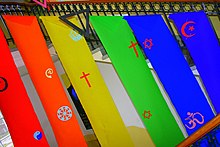
Back الدين وأفراد مجتمع الميم Arabic Religión y personas LGBT Spanish Persone LGBT e religione Italian

The relationship between religion and lesbian, gay, bisexual, and transgender (LGBT) people can vary greatly across time and place, within and between different religions and sects, and regarding different forms of homosexuality, bisexuality, non-binary, and transgender identities. More generally, the relationship between religion and sexuality ranges widely among and within them, from giving sex and sexuality a rather negative connotation to believing that sex is the highest expression of the divine.[1]
According to sociologists and researchers in social sciences, religion plays an important role in how heteronormative societies view LGBTQ+ people and same-sex couples, and their abilities to be functional beings in societal contexts.[2] Some of the authoritative bodies, texts, and doctrines of the world's largest religions may view these negatively, especially those that belong to Abrahamic religions.[3][4][5][6][7][8][9] This can range from discrimination and discouragement of self-disclosure directed at LGBTQ+ people,[10] explicitly forbidding same-sex sexual activities and/or gender reassignment among adherents, actively opposing social acceptance of LGBTQ+ identities,[3][9][11][12] to the criminalization and violence against LGBTQ+ people,[9][13][14][15] such as death penalty for people engaging in homosexual practices[13][14][15] while tolerating gender reassignment in specific cases.[16][17][18]
Liberal and progressive voices within these religions tend to view LGBTQ+ people more positively, and some liberal religious denominations may bless same-sex marriages, as well as accepting and marrying people who are transgender. Historically, some cultures and religions accommodated, institutionalized, revered and/or tolerated same-sex relationships and non-heterosexual identities;[15][18][19][20][21][22] such mythologies and traditions can be found in numerous religions around the world;[23] elements of religious and cultural incorporation of non-heterosexual identities can still be identified in traditions that have survived into the modern era, such as the Berdache,[24] Hijra,[25] and Xanith.[26]
- ^ Urban, Hugh B. (2010). "Chapter 4 – The Sacrifice of Desire: Sexual Rites and the Secret Sacrifice". The Power of Tantra: Religion, Sexuality, and the Politics of South Asian Studies. London and New York: I.B. Tauris. pp. 99–124. doi:10.5040/9780755625185.ch-004. ISBN 978-0-7556-2518-5.
- ^ Whitehead, Andrew L. (February 2018). "Homosexuality, Religion, and the Family: The Effects of Religion on Americans' Appraisals of the Parenting Abilities of Same-Sex Couples". Journal of Homosexuality. 65 (1). Taylor & Francis: 42–65. doi:10.1080/00918369.2017.1310550. ISSN 0091-8369. PMID 28332944. S2CID 40252656.
- ^ a b Fetner, Tina (August 2001). "Working Anita Bryant: The Impact of Christian Anti-Gay Activism on Lesbian and Gay Movement Claims". Social Problems. 48 (3). Oxford and New York: Oxford University Press on behalf of the Society for the Study of Social Problems: 411–428. doi:10.1525/sp.2001.48.3.411. hdl:11375/21175. ISSN 1533-8533. S2CID 144876642.
- ^ Cite error: The named reference
Int J Transgend.was invoked but never defined (see the help page). - ^ Cite error: The named reference
Graham 2017was invoked but never defined (see the help page). - ^ Cite error: The named reference
Mbuwayesango 2016was invoked but never defined (see the help page). - ^ Cite error: The named reference
Leeming 2003was invoked but never defined (see the help page). - ^ Cite error: The named reference
Gnuse 2015was invoked but never defined (see the help page). - ^ a b c Cite error: The named reference
lawnet.fordham.eduwas invoked but never defined (see the help page). - ^ Siraj, Asifa (September 2012). ""I Don't Want to Taint the Name of Islam": The Influence of Religion on the Lives of Muslim Lesbians". Journal of Lesbian Studies. 16 (4: Lesbians, Sexuality, and Islam). Taylor & Francis: 449–467. doi:10.1080/10894160.2012.681268. PMID 22978285. S2CID 22066812.
- ^ Ruel, Erin; Campbell, Richard T. (June 2006). "Homophobia and HIV/AIDS: Attitude Change in the Face of an Epidemic". Social Forces. 84 (4). Oxford and New York: Oxford University Press for the Department of Sociology at the University of North Carolina at Chapel Hill: 2167–2178. doi:10.1353/sof.2006.0110. ISSN 0037-7732. JSTOR 3844494. S2CID 145701441.
- ^ Gannon, Thomas M. (July–September 1981). "The New Christian Right in America as a Social and Political Force". Archives de Sciences Sociales des Religions. 26 (52–1). Paris: Éditions de l'EHESS: 69–83. doi:10.3406/assr.1981.2226. ISSN 0335-5985. JSTOR 30125411.
- ^ a b Cite error: The named reference
Ibrahim 2016was invoked but never defined (see the help page). - ^ a b Cite error: The named reference
www.hrw.orgwas invoked but never defined (see the help page). - ^ a b c Cite error: The named reference
iranica-lawwas invoked but never defined (see the help page). - ^ Cite error: The named reference
TransgenderHealth 2020was invoked but never defined (see the help page). - ^ Cite error: The named reference
Transgenderism 2017was invoked but never defined (see the help page). - ^ a b Cite error: The named reference
TEOEMwas invoked but never defined (see the help page). - ^ Cite error: The named reference
Schmidtke 1999was invoked but never defined (see the help page). - ^ Cite error: The named reference
Islamic Homosexualitieswas invoked but never defined (see the help page). - ^ Boswell, John (2005). Christianity, social tolerance, and homosexuality. University of Chicago Press.
- ^ Dynes, Wayne; Donaldson, Stephen (1992). Asian homosexuality. Routledge. ISBN 978-0-8153-0548-4.
- ^ Carpenter, Edward (1914). Intermediate Types among Primitive Types: A Study in Social Evolution. New York: Mitchell Kennerley. ISBN 978-0-405-07352-6.
- ^ Williams, Walter (1992). The Spirit and the Flesh: Sexual Diversity in American Indian Culture. Beacon House. ISBN 978-0-8070-4602-9.
- ^ Nanda, Serena (1998). Neither Man Nor Woman. Wadsworth Publishing. ISBN 978-0-534-12204-1.
- ^ Wikan, Unni (September 1978). "The Omani Xanith: A Third Gender Role?". Man. New Series. 13 (3): 473–475.
© MMXXIII Rich X Search. We shall prevail. All rights reserved. Rich X Search